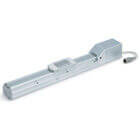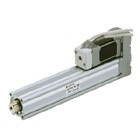- 91porn��Ƶ Home
- Products
- Secondary Battery
- Electric Actuators
Electric Actuators
Electric linear actuators can push, pull, or transfer workloads differently than pneumatic actuators. Pneumatic actuators rely on relatively crude devices such as rubber cushions or shock absorbers, pressure regulators, and flow restricting fittings at the port to control their motion. By contrast, an electric actuator employs an electronically controlled motor and ballscrew to deliver a precise motion profile through acceleration, speed, and deceleration. Further, the controller can integrate multiple "stop" positions along the actuator's stroke with high precision and repeatability.
The 25A- series variations are compatible with secondary battery manufacturing for electronics automotive, and other vehicle types. Design goals include eliminating copper (Cu) and Zinc (Zn) material where possible and employing a low dew point grease that retains lubricity even in low manufacturing temperatures. Please note that copper and zinc materials are used for the motors, cables, controllers and drivers.

Sliders
Rodless type electric actuators feature load mounting platforms situated above a ball screw drive or belt drive. Ball screw type advantages are better positioning repeatability than belt drives. Belt drive provides a more economical offering.
The 25A- series variations are designed using material compatible with secondary battery applications and are able to be used in low dew point environments. The variations eliminate copper (Cu) and zinc (Zn) material where possible, making them compatible with secondary battery manufacturing for electronics, automotive, and other vehicle types.

AC Servo Sliders
AC servo slider type electric actuators are similar to the slider type, except they utilize an AC servo motor instead of a DC type. The AC servo motor enables higher speed and acceleration, as well as improved vertical load capability. The drivers are pulse input type, with both incremental and absolute encoder options and 17- or 18-bit resolution.
The 25A- series variations are designed using material compatible with secondary battery applications and are able to be used in low dew point environments. The variations eliminate copper (Cu) and zinc (Zn) material where possible, making them compatible with secondary battery manufacturing for electronics, automotive, and other vehicle types.

Rod & Guided
The rod type electric actuators have a familiar rod cylinder form suitable for push, pull, lift, and press applications. The guide rod type includes rods to counter rotational forces instead of the drive and motor, and resists shock and sustained lateral loads.
The 25A- series variations are designed using material compatible with secondary battery applications and are able to be used in low dew point environments. The variations eliminate copper (Cu) and zinc (Zn) material where possible, making them compatible with secondary battery manufacturing for electronics, automotive, and other vehicle types.

AC Servo Rod
AC servo rod type electric actuators are similar to the rod and guided rod types, except they utilize an AC servo motor instead of a DC type. The AC servo motor enables higher speed and acceleration, as well as improved vertical load capability. The drivers are pulse input type, with both incremental and absolute encoder options and 17- or 18-bit resolution.
The 25A- series variations are designed using material compatible with secondary battery applications and are able to be used in low dew point environments. The variations eliminate copper (Cu) and zinc (Zn) material where possible, making them compatible with secondary battery manufacturing for electronics, automotive, and other vehicle types.
Product & CAD Models
- Actuators
- 91porn��Ƶ
- Airline Equipment
- Air Dryers Main Line Filters
- Connectors
- Vacuum Products
- Industrial Communication
- Sensors Switches Controllers
- Fluid Process
- Static Control
- Electric Actuators
- Chillers
- Process Gas Equipment
- High Vacuum
- Chemical Handling Equipment
- Cobot Gripping Solutions
- Secondary Battery